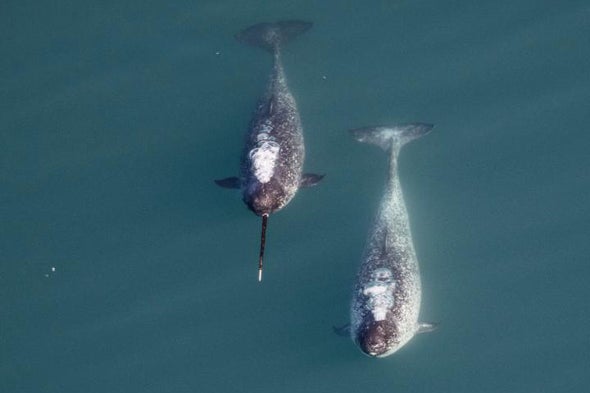(单词翻译:单击)
听力文本
This is Scientific American's 60-second Science. I'm Jason Goldman.
Deep beneath the frozen surface of the Arctic swims a sea unicorn. In reality, it's a whale with a spiral tusk sprouting from its head—the narwhal. Biologists have long debated the purpose of male narwhals' tusks. The tusk, like those of elephants, are actually elongated teeth. And since narwhals are usually below the sea ice, it's tough to see how they use their tusk.
"It turns out we don't know pretty much anything about them, because they're impossible to study in the wild."
Arizona State University evolutionary biology graduate student Zackary Graham. He wondered if the males' tusks were a sign of status as a potential reproductive partner. Comparing tusk size to the whales' overall body size could provide evidence.
"One of the main trends that has been documented in over 100 different animals of one hundred different traits is disproportionate growth. We call that hyperallometry. All that means is that the sexual trait is growing disproportionately, compared to the rest of the body. So it's not like the biggest narwhal is just a scaled up version of a baby narwhal. What we see is that the tusk is disproportionately long. And then we also see that there is intensive variation."
So Graham and his team turned to measurements collected from 250 adult males over 35 years.
"The majority of them are from the Inuit hunt. So the Inuit have been killing narwhals for thousands and thousands of years. And any time they do that, the Greenland Institute of Natural Resources asks them to collect a bunch of data."

Turns out the length of the tusks can vary widely even for males the same size, ranging from a foot and a half to more than eight feet. The finding is in the journal Biology Letters.
The top tusks thus appear to be like a billboard that shouts, "Look at me. I'm the biggest." After all, only the strongest, best fed individuals can afford to produce such an ostentatious ornament. Of course, tusks can do more than just say, "Hey, how you doin'?"
"But the fact that these narwhals always have these scars on them makes us think that it's likely a communication structure that also functions as a weapon."
For Graham, there's also a larger issue: some evolutionary biologists have recently proposed a hypothesis that groups of animals with elaborate sexual signals are more likely to speciate and diversify than those without.
"We know the world is changing around us more than ever, so understanding how and why species are going to be able to adapt and deal with this is key if we are to protect and manage the species we have on earth today."
Thanks for listening for Scientific American's 60-second Science. I'm Jason Goldman.
参考译文
这里是科学美国人——60秒科学。我是杰森·古德曼。
在北极冰冻海面的深层,游动着海洋独角兽。实际上,这是一种头上长着螺旋状象牙的鲸鱼——独角鲸。生物学家一直就雄性独角鲸长牙的作用争论不休。像大象一样,这些长牙实际上是拉长的牙。而且,由于独角鲸通常在海冰下,因此很难看到它们如何使用长牙。
“事实证明我们对独角鲸不太了解,因为不可能在野外研究它们。”
亚利桑那州立大学的进化生物学研究生扎卡里·格雷厄姆说到。他想知道雄性的长牙是否是潜在繁殖配偶的身份标志。将长牙大小与独角鲸的整体体型进行对比可以提供证据。
“在拥有各种特征的100多种动物身上,我们记录下的主要趋势之一是生长不均。我们称之为超异速生长。这意味着,与身体其它部位相比,性特征的生长不成比例。因此,最大的独角鲸并不是小独角鲸的放大版。我们看到的是,长牙过长,与身体不成比例。之后我们还会看到剧烈变化。”
因此,格雷厄姆及其团队找来了35年来从250只雄性成年独角鲸身上收集而来的测量结果。
“测量数据大多来自因纽特人的捕猎。因此,因纽特人捕猎独角鲸的历史已有数千年。他们无论在何时捕猎,格陵兰自然资源研究所都要求他们收集大量数据。”
结果发现,即使是体型相同的雄性,长牙长度也可能差异世大,从1.5英尺到8英尺不等。这项研究发表在《生物学通讯》期刊上。
这样看来,头顶长牙看起来像是高喊“看我,我最大”的广告牌。毕竟,只有最强壮、营养最足的个体才能长出如此炫的装饰品。当然,长牙的作用不仅仅是说“嘿,你怎么样?”
“但这些独角鲸身上常有伤疤,我们认为,这很可能是具有武器功能的通讯结构。”
对于格雷厄姆来说,还有个更大的问题:一些进化生物学家最近提出了一个假设,即拥有复杂性信号的动物比没有的动物更容易形成物种并多样化。
“我们知道周围的世界正在经历前所未有的变化,因此,如果我们要保护和管理我们今天地球上的现有物种,关键就是要了解物种如何以及为何能够适应和处理这种变化。”
谢谢大家收听科学美国人——60秒科学。我是杰森·古德曼。
译文为可可英语翻译,未经授权请勿转载!
重点讲解
重点讲解:
1. in reality 事实上;实际上;
He came across as streetwise, but in reality he was not.
他给人的印象是很适应都市生活,但实际上并非如此。
2. compared to 与…相比;和…比起来;
I was at a disadvantage compared to the younger members of the team.
与队里较年轻的队员相比,我处于不利地位。
3. after all 毕竟;终究;
Things weren't so bad, after all. I was among friends again.
情况还不是那么糟糕,毕竟我又回到了朋友当中。
4. deal with 处理;应付;与…打交道;
We must take positive steps to deal with the problem.
我们必须采取积极步骤处理这个问题。


